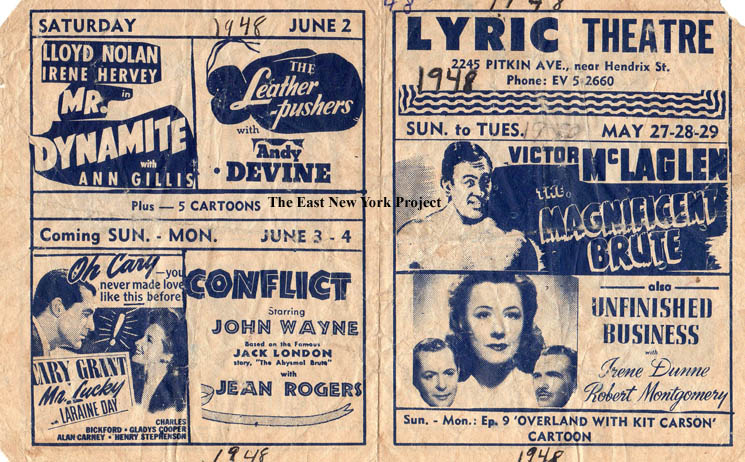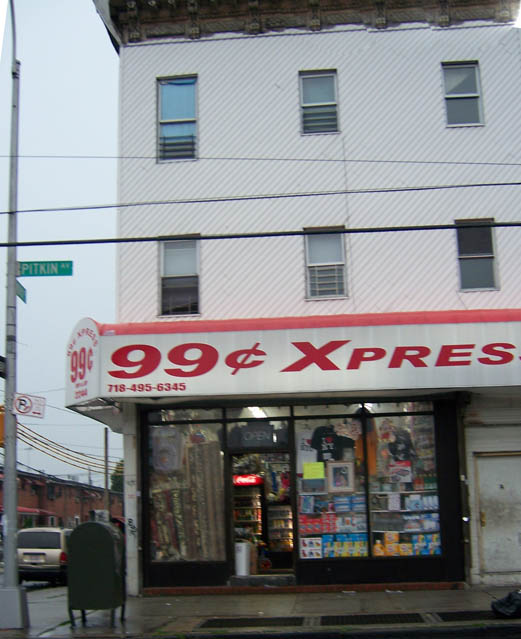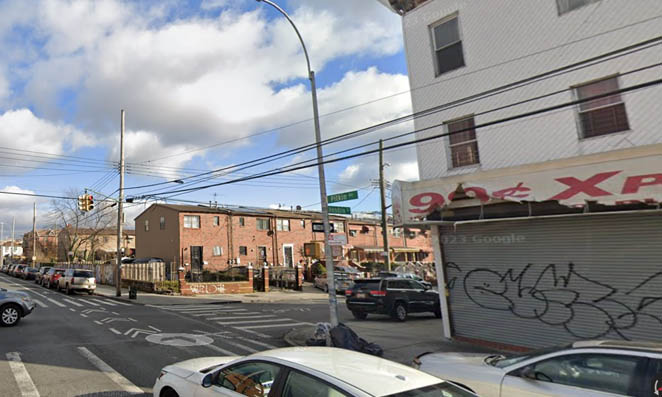Hendrix Street
South of Atlantic Avenue
Formerly Smith Street, changed in 1887. I'm guessing it was named after Joseph C. Hendrix. Hendrix was a trustee for the Brooklyn Bridge association, was appointed Postmaster by then Governor Cleveland, was President of the Board of Education, the Kings County Trust Co., the American Bankers Association. He failed in a run for Mayor but became a Congressman.
Click on thumbnails to enlarge
|
 |
 |
Ahaveth Chesed Day Nursery
Demetrius Pestun sent over this shot of 394 Hendrix, which used to be a Hebrew day nursery. On the right is a 1951 BPL shot taken on the property. The Nursery was established in 1917 to "take care of poor children while their mothers were at work". The 1919 Jewish Yearbook listed D.L. Marcus, 369 Vermont Street as president. The building is now used ny the NY Psychotherapy and Counseling Center. |
 |
 |
Lyric Theater, Hendrix and Pitkin
Originally constructed as the Hendrix Theater in 1915, the name change occured around 1935 and the seating changed from 500 seats to 400 seats. It closed in 1952. That information from 'Cinema Treasures'. Photos are courtesy of Neil Sullivan. |
 |
|
Lyric Theater flybill, 1948
Vincent Anello wrote; "The hand bill brings back memories, they made great paper airplanes (the paper was coated) we would go to the second floor open the window and let them fly (the bathrooms were on the second floor). The Lyric closed about 1953 and became a factory,I painted a box on the wall to practice pitching and play stickball." |
 |
 |
2258 Pitkin Avenue, Dane's Spaghetti House, 1930s
A former classmate of mine 60 years ago at P.S. 108, James Meglino, sent in this photo of his grandfather's Spaghetti House at 2258 Pitkin Avenue. "The Buglione Family Donato, Olympia,Vincent(Jimmy), Tony,Louise,Josephine and Victor." On the right is a view of the block, looking west from Schenck towards Hendrix Street in 1963. The building with the "Bar" awning was the site of the restaurant. |
 |
 |
Southwest corner, Pitkin and Hendrix
It was a sure sign that East New York hit rock bottom when the 1985 movie "Death Wish 3" was filmed on location. Charles Bronson is seen running around the corner of Hendrix and Pitkin in this scene. Looking east across Hendrix Street, in the background you can see the block above has been completely demolished. On the right is how the corner appeared in 1938, when the el was still standing. |
 |
 |
Southwest corner, Pitkin and Hendrix
That building is still standing today. Long-time site fan Mike (Red) Bivona lived in an apartment there, and recalls the storefront was a supermarket and later a sewing machine factory. Mike sent over a 2009 picture of the corner from the late Rod Maggio. I added a 2022 image to show the new housing constructed more recently. |
 |
 |
Vinnie Anello sends over 2 shots of him from the 1960s on Hendrix Street. On the left, the view is in front of 351 Hendrix in 1966. On the right, a touch football game in 1967 with the redbrick old Lyric Theatre, then a factory, in the background. |
 |
 |
Blake Avenue, looking east from Hendrix Street, 1962
The building indicated by the arrow was the former Blake Theater, which only operated from 1920 to 1928. For a period of time afterwards it housed a plumbing supply company. Both sides of this block have long been cleared and replaced with new housing as seen in the 2024 image on the right. |
 |
 |
676 Hendrix , 1939 and today
Ellen Grove had sent me these shots awhile back- a former residence located between New Lots and Livonia Avenue. |
 |
 |
623 Hendrix , 1957
Richard Woitowitz lived at 623 Hendrix in the late 50s, and provides this next series of shots. This pair is circa 1957 showing Richard in front of his house, which I investigated and confirmed is no longer standing. |
 |
 |
623 Hendrix , 1957
The next pair of shots from Richard provide a view across the street from 623 Hendrix around the same time. On the left Richard only recalls the tallest girl was Lorraine. On the right is Richard with his mother Helen. |
 |
 |
623 Hendrix , 1957
This pair offer different views; south down Hendrix where the Livonia Ave. el can be seen in the background. On the right Richard is pictured with his camp counselor from F K Lane Day Camp. The shot is at the north end of the block, by Dumont Ave. near P.S. 182. I think I like these shots more for the cars; check out the fins on the one on the right. |
 |
 |
749 Hendrix, Atehereth Eliezer Glovinsky
This synagogue, seen in the 1940 tax photo, and the adjoining building at 749 Hendrix was sold to the House of David congregation in 1971 and continues in use today.. |
 |
 |
Linden Houses, Bnai Brith
Now we are south of Linden Boulevard. The Linden Houses Projects date to 1956. Congregation Bnai Israel, operating out of a store at 657 Stanley Avenue, purchased 9 lots from the City of New York on the east side of Hendrix Street in 1955. They open a synagogue, a school, and a recreation center across from the Linden Houses. This property was eventually bought by the St. Paul Community Baptist Church. The Rev. Johnny Ray Youngblood took over in 1974 and led a revival that by 1993 had seen the congregation swell to 5,000 members. Rev. Youngblood is credited with leading the revival of the area as well. His work was featured in a 1993 documentary, God's Alcatraz . |
 |
|
So how far does Hendrix Street go? Although it is cut off by the Linden Houses, it picks up again and keeps going, to Flatlands Avenue. I believe it technically ends there for the public, but south of Flatlands are all the sewage treatment plants. The continues past the Belt Parkway, all the way to a dock out in Jamaica Bay. The original 26th Ward treatment plant was constructed circa 1895 alongside Hendrix Creek. |







